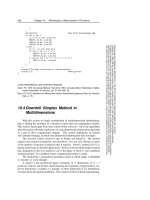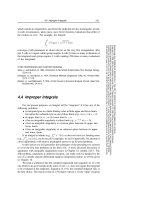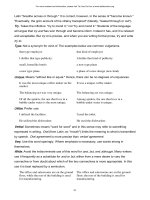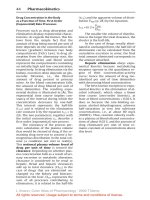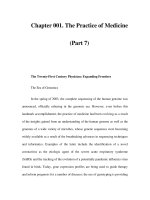Chapter 074. Biology of Obesity (Part 5) docx
Bạn đang xem bản rút gọn của tài liệu. Xem và tải ngay bản đầy đủ của tài liệu tại đây (72.91 KB, 7 trang )
Chapter 074. Biology of Obesity
(Part 5)
Figure 74-5
A central pathway through which leptin acts to regulate appetite and
body weight. Leptin signals through proopiomelanocortin (POMC) neurons in the
hypothalamus to induce increased production of α-melanocyte-stimulating
hormone (α-MSH), requiring the processing enzyme PC-1 (proenzyme convertase
1). α-MSH acts as an agonist on melanocortin-4 receptors to inhibit appetite, and
the neuropeptide AgRp (Agouti-related peptide) acts as an antagonist of this
receptor. Mutations that cause obesity in humans are indicated by the solid green
arrows.
In addition to these human obesity genes, studies in rodents reveal several
other molecular candidates for hypothalamic mediators of human obesity or
leanness. The tub gene encodes a hypothalamic peptide of unknown function;
mutation of this gene causes late-onset obesity. The fat gene encodes
carboxypeptidase E, a peptide-processing enzyme; mutation of this gene is
thought to cause obesity by disrupting production of one or more neuropeptides.
AgRP is coexpressed with NPY in arcuate nucleus neurons. AgRP antagonizes α-
MSH action at MC4 receptors, and its overexpression induces obesity. In contrast,
a mouse deficient in the peptide MCH, whose administration causes feeding, is
lean.
A number of complex human syndromes with defined inheritance are
associated with obesity (Table 74-2). Although specific genes are undefined at
present, their identification will likely enhance our understanding of more
common forms of human obesity. In the Prader-Willi syndrome, obesity coexists
with short stature, mental retardation, hypogonadotropic hypogonadism,
hypotonia, small hands and feet, fish-shaped mouth, and hyperphagia. Most
patients have a chromosome 15 deletion, and reduced expression of the signaling
protein necdin may be an important cause of defective hypothalamic neural
development in this disorder (Chap. 63). Bardet-Biedl syndrome (BBS) is a
genetically heterogeneous disorder characterized by obesity, mental retardation,
retinitis pigmentosa, renal and cardiac malformations, polydactyly, and
hypogonadotropic hypogonadism. At least eight genetic loci have been identified,
and BBS may involve defects in ciliary function.
Table 74-2 A Comparison of Syndromes of Obesity—Hypogonadism
and Mental Retardation
Syndrome
Feat
ure
Pra
der-Willi
Lau
rence-
Moon-
Biedl
Ahlst
rom
Coh
en
Car
penter
Inher
itance
Spor
adic; two-
thirds have
defect
Aut
osomal
recessive
Autos
omal
recessive
Prob
ably
autosomal
recessive
Aut
osomal
recessive
Statu Shor Nor Norm Shor Nor
re t mal;
infrequentl
y short
al;
infrequently
short
t or tall mal
Obes
ity
Gen
eralized
Mod
erate to
severe
Ons
et 1–3 yrs
Gen
eralized
Earl
y onset, 1–
2 yrs
Trunc
al
Early
onset, 2–5
yrs
Tru
ncal
Mid
-childhood,
age 5
Trun
cal, gluteal
Cran
iofacies
Narr
ow
bifrontal
diameter
Alm
ond-shaped
eyes
Not
distinctive
Not
distinctive
Hig
h nasal
bridge
Arc
hed palate
Ope
n mouth
Acr
ocephaly
Flat
nasal
bridge
Hig
h-arched
Stra
bismus
V-
shaped
mouth
High
-arched
palate
Shor
t philtrum
palate
Lim
bs
Sma
ll hands
and feet
Hyp
otonia
Pol
ydactyly
No
abnormalitie
s
Hyp
otonia
Narr
ow hands
and feet
Poly
dactyly
Syn
dactyly
Gen
u valgum
Repr
oductive
status
1°
Hypogonad
ism
1°
Hypogona
dism
Hypo
gonadism in
males but
Nor
mal
gonadal
2°
Hypogonad
ism
not in
females
function or
hypogonad
otrophic
hypogonad
ism
Othe
r features
Ena
mel
hypoplasia
Hyp
erphagia
Tem
per
tantrums
Nasa
l speech
Dys
plastic ears
Dela
yed
puberty
Ment
al
Mild
to moderate
Norm
al
Mil
d
Slig
ht
retardation intelligence
